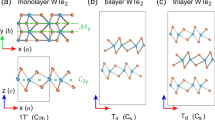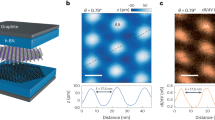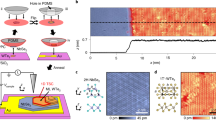Abstract
Recent experimental evidence for the quantum spin Hall (QSH) state in monolayer WTe2 has linked the fields of two-dimensional materials and topological physics1,2,3,4,5,6,7. This two-dimensional topological crystal also displays unconventional spin–torque8 and gate-tunable superconductivity7. Whereas the realization of the QSH has demonstrated the nontrivial topology of the electron wavefunctions of monolayer WTe2, the geometrical properties of the wavefunction, such as the Berry curvature9, remain unstudied. Here we utilize mid-infrared optoelectronic microscopy to investigate the Berry curvature in monolayer WTe2. By optically exciting electrons across the inverted QSH gap, we observe an in-plane circular photogalvanic current even under normal incidence. The application of an out-of-plane displacement field allows further control of the direction and magnitude of the photocurrent. The observed photocurrent reveals a Berry curvature dipole that arises from the nontrivial wavefunctions near the inverted gap edge. The Berry curvature dipole and strong electric field effect are enabled by the inverted band structure and tilted crystal lattice of monolayer WTe2. Such an electrically switchable Berry curvature dipole may facilitate the observation of a wide range of quantum geometrical phenomena such as the quantum nonlinear Hall10,11, orbital-Edelstein12 and chiral polaritonic effects13,14.
This is a preview of subscription content, access via your institution
Access options
Access Nature and 54 other Nature Portfolio journals
Get Nature+, our best-value online-access subscription
$29.99 / 30 days
cancel any time
Subscribe to this journal
Receive 12 print issues and online access
$209.00 per year
only $17.42 per issue
Buy this article
- Purchase on Springer Link
- Instant access to full article PDF
Prices may be subject to local taxes which are calculated during checkout




Similar content being viewed by others
References
Qian, X., Liu, J., Fu, L. & Li, J. Quantum spin Hall effect in two-dimensional transition metal dichalcogenides. Science 346, 1344–1347 (2014).
Zheng, F. et al. On the quantum spin Hall gap of monolayer 1T′–WTe2. Adv. Mater. 28, 4845–4851 (2016).
Fei, Z. et al. Edge conduction in monolayer WTe2. Nat. Phys. 13, 677–682 (2017).
Tang, S. et al. Quantum spin Hall state in monolayer 1T′-WTe2. Nat. Phys. 13, 683–687 (2017).
Jia, Z.-Y. et al. Direct visualization of a two-dimensional topological insulator in the single-layer 1T′-WTe2. Phys. Rev. B 96, 041108 (2017).
Wu, S. et al. Observation of the quantum spin Hall effect up to 100 kelvin in a monolayer crystal. Science 359, 76–79 (2018).
Wu, S. et al. Observation of Topological Insulating and Superconducting Ground States of Monolayer WTe2. Bull. Am. Phys. Soc. https://meetings.aps.org/Meeting/MAR18/Session/B37.4 (2018).
MacNeill, D. et al. Control of spin–orbit torques through crystal symmetry in WTe2 ferromagnet bilayers. Nat. Phys. 13, 300–305 (2016).
Nagaosa, N., Sinova, J., Onoda, S., MacDonald, A. & Ong, N. P. Anomalous Hall effect. Rev. Mod. Phys. 82, 1539–1592 (2010).
Moore, J. E. & Orenstein, J. Confinement-induced Berry phase and helicity-dependent photocurrents. Phys. Rev. Lett. 105, 026805 (2010).
Sodemann, I. & Fu, L. Quantum nonlinear Hall effect induced by Berry curvature dipole in time-reversal invariant materials. Phys. Rev. Lett. 115, 216806 (2015).
Yoda, T., Yokoyama, T. & Murakami, S. Orbital Edelstein effect as a condensed-matter analog of solenoid. Nano Lett. 18, 916–920 (2018).
Basov, D., Fogler, M. & de Abajo, F. G. Polaritons in van der Waals materials. Science 354, aag1992 (2016).
Low, T. et al. Polaritons in layered two-dimensional materials. Nat. Mater. 16, 182–194 (2017).
Ideue, T. et al. Bulk rectification effect in a polar semiconductor. Nat. Phys. 13, 578–583 (2017).
Rikken, G. & Raupach, E. Observation of magneto-chiral dichroism. Nature 390, 493–494 (1997).
Xu, X., Yao, W., Xiao, D. & Heinz, T. F. Spin and pseudospin in layered transition metal dichalcogenides. Nat. Phys. 10, 343–350 (2014).
Mak, K. F. & Shan, J. Photonics and optoelectronics of 2D semiconductor transition metal dichalcogenides. Nat. Photon. 10, 216–226 (2016).
de Juan, F., Grushin, A. G., Morimoto, T. & Moore, J. E. Quantized circular photogalvanic effect in Weyl semimetals. Nat. Commun. 8, 15995 (2017).
Son, D. & Spivak, B. Chiral anomaly and classical negative magnetoresistance of Weyl metals. Phys. Rev. B 88, 104412 (2013).
Gradhand, M. & Annett, J. F. The Berry curvature of the Bogoliubov quasiparticle Bloch states in the unconventional superconductor Sr2RuO4. J. Phys. Condens. Matter 26, 274205 (2014).
Ali, M. N. et al. Large, non-saturating magnetoresistance in WTe2. Nature 514, 205–211 (2014).
Soluyanov, A. et al. Type-II Weyl semimetals. Nature 527, 495–498 (2015).
Sipe, J. & Shkrebtii, A. Second-order optical response in semiconductors. Phys. Rev. B 61, 5337–5352 (2000).
Wittmann, B. et al. Circular photogalvanic effect in HgTe/CdHgTe quantum well structures. Semicond. Sci. Technol. 25, 095005 (2010).
Hosur, P. Circular photogalvanic effect on topological insulator surfaces: Berry-curvature-dependent response. Phys. Rev. B 83, 035309 (2011).
McIver, J., Hsieh, D., Steinberg, H., Jarillo-Herrero, P. & Gedik, N. Control over topological insulator photocurrents with light polarization. Nat. Nanotech. 7, 96–100 (2012).
Yuan, H. et al. Generation and electric control of spin–valley-coupled circular photogalvanic current in WSe2. Nat. Nanotech. 9, 851–857 (2014).
Ma, Q. et al. Direct optical detection of Weyl fermion chirality in a topological semimetal. Nat. Phys. 13, 842–847 (2017).
Muechler, L., Alexandradinata, A., Neupert, T. & Car, R. Topological nonsymmorphic metals from band inversion. Phys. Rev. X 6, 041069 (2016).
Wu, S. et al. Electrical tuning of valley magnetic moment through symmetry control in bilayer MoS2. Nat. Phys. 9, 149–153 (2013).
Dhara, S., Mele, E. J. & Agarwal, R. Voltage-tunable circular photogalvanic effect in silicon nanowires. Science 349, 726–729 (2015).
Zhang, Y., Sun, Y. & Yan, B. The Berry curvature dipole in Weyl semimetal materials: an ab initio study. Phys. Rev. B 97, 041101(R) (2017).
Lee, J., Wang, Z., Xie, H., Mak, K. & Shan, J. Valley magnetoelectricity in single-layer MoS2. Nat. Mater. 16, 887–891 (2017).
Taychatanapat, T. & Jarillo-Herrero, P. Electronic transport in dual-gated bilayer graphene at large displacement fields. Phys. Rev. Lett. 105, 166601 (2010).
Perdew, J. P., Burke, K. & Ernzerhof, M. Generalized gradient approximation made simple. Phys. Rev. Lett. 77, 3865–3868 (1996).
Heyd, J., Scuseria, G. E. & Ernzerhof, M. Hybrid functionals based on a screened Coulomb potential. J. Chem. Phys. 118, 8207–8215 (2003).
Yao, W., Xiao, D. & Niu, Q. Valley-dependent optoelectronics from inversion symmetry breaking. Phys. Rev. B 77, 235406 (2008).
Acknowledgements
We acknowledge Y. Lin and T. Palacios for their assistance on measurements. Work in the P.J.-H. group was partly supported by the Center for Excitonics, an Energy Frontier Research Center funded by the US Department of Energy (DOE), Office of Science, Office of Basic Energy Sciences (BES) under Award Number DESC0001088 (fabrication and measurement) and partly through AFOSR grant FA9550-16-1-0382 (data analysis), as well as the Gordon and Betty Moore Foundation’s EPiQS Initiative through Grant GBMF4541 to P.J.-H. This work made use of the Materials Research Science and Engineering Center Shared Experimental Facilities supported by the National Science Foundation (NSF) (Grant No. DMR-0819762). N.G. and S.Y.X. acknowledge support from DOE, BES DMSE (data taking and analysis), and the Gordon and Betty Moore Foundations EPiQS Initiative through Grant GBMF4540 (manuscript writing). The WTe2 crystal growth performed at Princeton University was supported by an NSF MRSEC grant, DMR-1420541 (Q.D.G. and R.J.C.). K.W. and T.T. acknowledge support from the Elemental Strategy Initiative conducted by the MEXT, Japan and JSPS KAKENHI Grant Numbers JP15K21722. H.S. and L.F. acknowledge support from NSF Science and Technology Center for Integrated Quantum Materials grant DMR-1231319 (theory). The WTe2 film growth performed at Nanyang Technological University was supported by MOE Tier 2 grants MOE2016-T2-2-153 and MOE2015-T2-2-007 and the Singapore National Research Foundation under NRF award number NRF-NRFF2013-08. T.R.C. was supported by the Ministry of Science and Technology under the MOST Grant for the Columbus Program NO. 107-2636-M-006-004, National Cheng Kung University, Taiwan, and National Center for Theoretical Sciences (NCTS), Taiwan.
Author information
Authors and Affiliations
Contributions
Q.M. and S.Y.X. performed the measurements and analysed the data with help from A.M.M.V. V.F. and S.W. fabricated the devices. Q.D.G. and R.J.C. grew the bulk WTe2 single crystals. K.W. and T.T. grew the bulk hBN single crystals. J.Z. and Z.L. grew the WTe2 CVD films. T.R.C., G.C. and H.L. calculated the first-principles band structures. S.Y.X., Q.M., H.S. and L.F. did theoretical analysis of the Berry curvature dipole with help from C.K.C. H.S. and L.F. performed analysis of the k ⋅ p model. S.Y.X. and Q.M. wrote the manuscript with input from all authors. P.J.-H. and N.G. supervised the project.
Corresponding authors
Ethics declarations
Competing interests
The authors declare no competing interests.
Additional information
Publisher’s note: Springer Nature remains neutral with regard to jurisdictional claims in published maps and institutional affiliations.
Electronic supplementary material
Supplementary Information
Supplementary figures S1 to S31, and Supplementary tables S1 to S5
Rights and permissions
About this article
Cite this article
Xu, SY., Ma, Q., Shen, H. et al. Electrically switchable Berry curvature dipole in the monolayer topological insulator WTe2. Nature Phys 14, 900–906 (2018). https://doi.org/10.1038/s41567-018-0189-6
Received:
Accepted:
Published:
Issue Date:
DOI: https://doi.org/10.1038/s41567-018-0189-6
This article is cited by
-
Giant intrinsic photovoltaic effect in one-dimensional van der Waals grain boundaries
Nature Communications (2024)
-
Intrinsic supercurrent non-reciprocity coupled to the crystal structure of a van der Waals Josephson barrier
Nature Communications (2024)
-
A tunable room-temperature nonlinear Hall effect in elemental bismuth thin films
Nature Electronics (2024)
-
Defect-induced helicity dependent terahertz emission in Dirac semimetal PtTe2 thin films
Nature Communications (2024)
-
Designing spin and orbital sources of Berry curvature at oxide interfaces
Nature Materials (2023)



